MAR015-2 Intercultural Management in Business: Case Study Analysis
VerifiedAdded on 2023/06/12
|9
|2259
|395
Case Study
AI Summary
This case study examines a failed joint venture between a US sports equipment company and a Japanese firm, highlighting the cultural missteps of the American representatives. It suggests that the Americans should have better understood Japanese culture, possibly through training and the application of Hofstede's cultural dimensions theory. The analysis covers power distance, individualism vs. collectivism, uncertainty avoidance, masculinity vs. femininity, long-term vs. short-term orientation, and indulgence vs. restraint, advising the American representatives to adopt a more respectful and culturally sensitive approach to future interactions. The report concludes that understanding intercultural differences is crucial for successful international business ventures and recommends using cultural theories to navigate these challenges effectively. Desklib provides similar case studies and resources for students.

Case Study
Paraphrase This Document
Need a fresh take? Get an instant paraphrase of this document with our AI Paraphraser
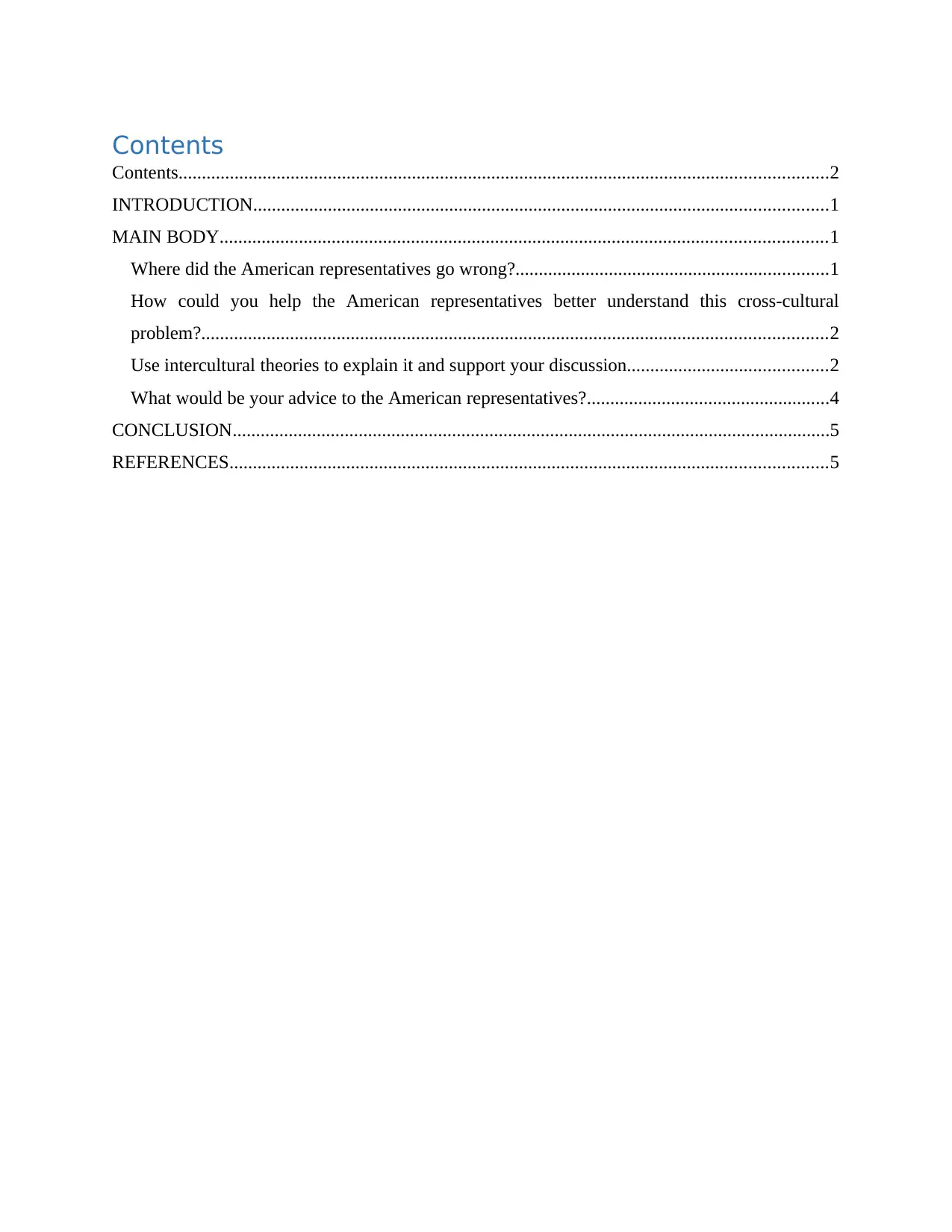
Contents
Contents...........................................................................................................................................2
INTRODUCTION...........................................................................................................................1
MAIN BODY..................................................................................................................................1
Where did the American representatives go wrong?...................................................................1
How could you help the American representatives better understand this cross-cultural
problem?......................................................................................................................................2
Use intercultural theories to explain it and support your discussion...........................................2
What would be your advice to the American representatives?....................................................4
CONCLUSION................................................................................................................................5
REFERENCES................................................................................................................................5
Contents...........................................................................................................................................2
INTRODUCTION...........................................................................................................................1
MAIN BODY..................................................................................................................................1
Where did the American representatives go wrong?...................................................................1
How could you help the American representatives better understand this cross-cultural
problem?......................................................................................................................................2
Use intercultural theories to explain it and support your discussion...........................................2
What would be your advice to the American representatives?....................................................4
CONCLUSION................................................................................................................................5
REFERENCES................................................................................................................................5

⊘ This is a preview!⊘
Do you want full access?
Subscribe today to unlock all pages.

Trusted by 1+ million students worldwide
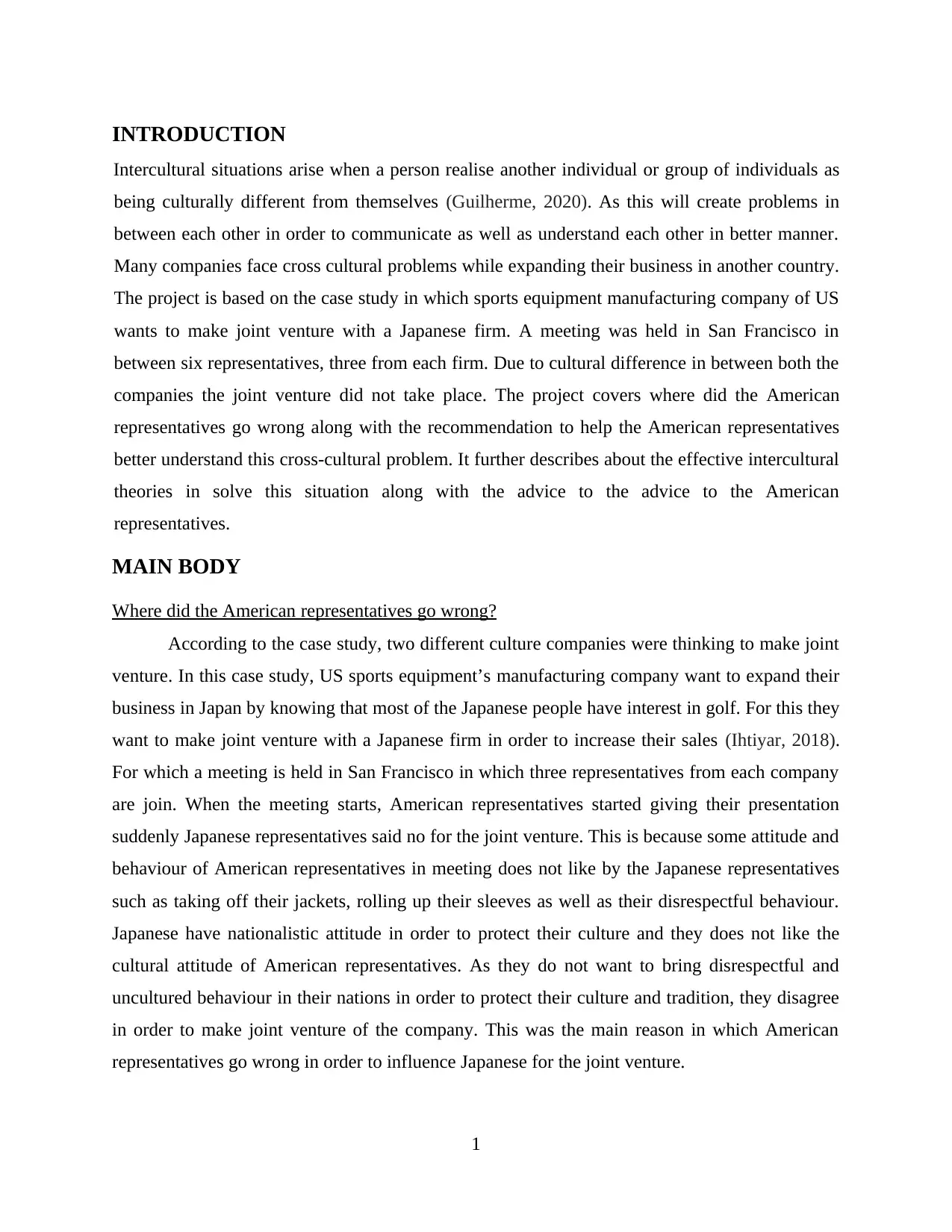
INTRODUCTION
Intercultural situations arise when a person realise another individual or group of individuals as
being culturally different from themselves (Guilherme, 2020). As this will create problems in
between each other in order to communicate as well as understand each other in better manner.
Many companies face cross cultural problems while expanding their business in another country.
The project is based on the case study in which sports equipment manufacturing company of US
wants to make joint venture with a Japanese firm. A meeting was held in San Francisco in
between six representatives, three from each firm. Due to cultural difference in between both the
companies the joint venture did not take place. The project covers where did the American
representatives go wrong along with the recommendation to help the American representatives
better understand this cross-cultural problem. It further describes about the effective intercultural
theories in solve this situation along with the advice to the advice to the American
representatives.
MAIN BODY
Where did the American representatives go wrong?
According to the case study, two different culture companies were thinking to make joint
venture. In this case study, US sports equipment’s manufacturing company want to expand their
business in Japan by knowing that most of the Japanese people have interest in golf. For this they
want to make joint venture with a Japanese firm in order to increase their sales (Ihtiyar, 2018).
For which a meeting is held in San Francisco in which three representatives from each company
are join. When the meeting starts, American representatives started giving their presentation
suddenly Japanese representatives said no for the joint venture. This is because some attitude and
behaviour of American representatives in meeting does not like by the Japanese representatives
such as taking off their jackets, rolling up their sleeves as well as their disrespectful behaviour.
Japanese have nationalistic attitude in order to protect their culture and they does not like the
cultural attitude of American representatives. As they do not want to bring disrespectful and
uncultured behaviour in their nations in order to protect their culture and tradition, they disagree
in order to make joint venture of the company. This was the main reason in which American
representatives go wrong in order to influence Japanese for the joint venture.
1
Intercultural situations arise when a person realise another individual or group of individuals as
being culturally different from themselves (Guilherme, 2020). As this will create problems in
between each other in order to communicate as well as understand each other in better manner.
Many companies face cross cultural problems while expanding their business in another country.
The project is based on the case study in which sports equipment manufacturing company of US
wants to make joint venture with a Japanese firm. A meeting was held in San Francisco in
between six representatives, three from each firm. Due to cultural difference in between both the
companies the joint venture did not take place. The project covers where did the American
representatives go wrong along with the recommendation to help the American representatives
better understand this cross-cultural problem. It further describes about the effective intercultural
theories in solve this situation along with the advice to the advice to the American
representatives.
MAIN BODY
Where did the American representatives go wrong?
According to the case study, two different culture companies were thinking to make joint
venture. In this case study, US sports equipment’s manufacturing company want to expand their
business in Japan by knowing that most of the Japanese people have interest in golf. For this they
want to make joint venture with a Japanese firm in order to increase their sales (Ihtiyar, 2018).
For which a meeting is held in San Francisco in which three representatives from each company
are join. When the meeting starts, American representatives started giving their presentation
suddenly Japanese representatives said no for the joint venture. This is because some attitude and
behaviour of American representatives in meeting does not like by the Japanese representatives
such as taking off their jackets, rolling up their sleeves as well as their disrespectful behaviour.
Japanese have nationalistic attitude in order to protect their culture and they does not like the
cultural attitude of American representatives. As they do not want to bring disrespectful and
uncultured behaviour in their nations in order to protect their culture and tradition, they disagree
in order to make joint venture of the company. This was the main reason in which American
representatives go wrong in order to influence Japanese for the joint venture.
1
Paraphrase This Document
Need a fresh take? Get an instant paraphrase of this document with our AI Paraphraser
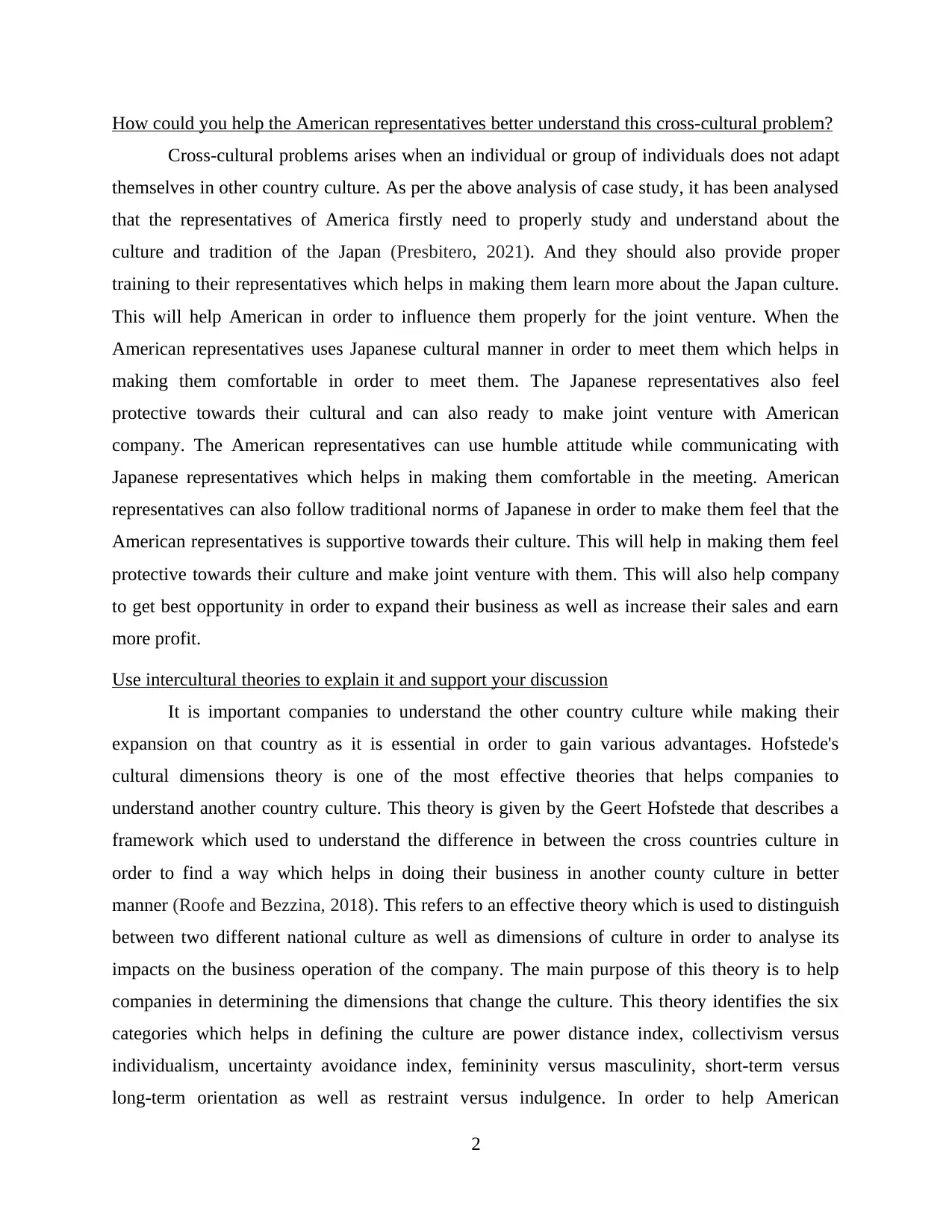
How could you help the American representatives better understand this cross-cultural problem?
Cross-cultural problems arises when an individual or group of individuals does not adapt
themselves in other country culture. As per the above analysis of case study, it has been analysed
that the representatives of America firstly need to properly study and understand about the
culture and tradition of the Japan (Presbitero, 2021). And they should also provide proper
training to their representatives which helps in making them learn more about the Japan culture.
This will help American in order to influence them properly for the joint venture. When the
American representatives uses Japanese cultural manner in order to meet them which helps in
making them comfortable in order to meet them. The Japanese representatives also feel
protective towards their cultural and can also ready to make joint venture with American
company. The American representatives can use humble attitude while communicating with
Japanese representatives which helps in making them comfortable in the meeting. American
representatives can also follow traditional norms of Japanese in order to make them feel that the
American representatives is supportive towards their culture. This will help in making them feel
protective towards their culture and make joint venture with them. This will also help company
to get best opportunity in order to expand their business as well as increase their sales and earn
more profit.
Use intercultural theories to explain it and support your discussion
It is important companies to understand the other country culture while making their
expansion on that country as it is essential in order to gain various advantages. Hofstede's
cultural dimensions theory is one of the most effective theories that helps companies to
understand another country culture. This theory is given by the Geert Hofstede that describes a
framework which used to understand the difference in between the cross countries culture in
order to find a way which helps in doing their business in another county culture in better
manner (Roofe and Bezzina, 2018). This refers to an effective theory which is used to distinguish
between two different national culture as well as dimensions of culture in order to analyse its
impacts on the business operation of the company. The main purpose of this theory is to help
companies in determining the dimensions that change the culture. This theory identifies the six
categories which helps in defining the culture are power distance index, collectivism versus
individualism, uncertainty avoidance index, femininity versus masculinity, short-term versus
long-term orientation as well as restraint versus indulgence. In order to help American
2
Cross-cultural problems arises when an individual or group of individuals does not adapt
themselves in other country culture. As per the above analysis of case study, it has been analysed
that the representatives of America firstly need to properly study and understand about the
culture and tradition of the Japan (Presbitero, 2021). And they should also provide proper
training to their representatives which helps in making them learn more about the Japan culture.
This will help American in order to influence them properly for the joint venture. When the
American representatives uses Japanese cultural manner in order to meet them which helps in
making them comfortable in order to meet them. The Japanese representatives also feel
protective towards their cultural and can also ready to make joint venture with American
company. The American representatives can use humble attitude while communicating with
Japanese representatives which helps in making them comfortable in the meeting. American
representatives can also follow traditional norms of Japanese in order to make them feel that the
American representatives is supportive towards their culture. This will help in making them feel
protective towards their culture and make joint venture with them. This will also help company
to get best opportunity in order to expand their business as well as increase their sales and earn
more profit.
Use intercultural theories to explain it and support your discussion
It is important companies to understand the other country culture while making their
expansion on that country as it is essential in order to gain various advantages. Hofstede's
cultural dimensions theory is one of the most effective theories that helps companies to
understand another country culture. This theory is given by the Geert Hofstede that describes a
framework which used to understand the difference in between the cross countries culture in
order to find a way which helps in doing their business in another county culture in better
manner (Roofe and Bezzina, 2018). This refers to an effective theory which is used to distinguish
between two different national culture as well as dimensions of culture in order to analyse its
impacts on the business operation of the company. The main purpose of this theory is to help
companies in determining the dimensions that change the culture. This theory identifies the six
categories which helps in defining the culture are power distance index, collectivism versus
individualism, uncertainty avoidance index, femininity versus masculinity, short-term versus
long-term orientation as well as restraint versus indulgence. In order to help American
2
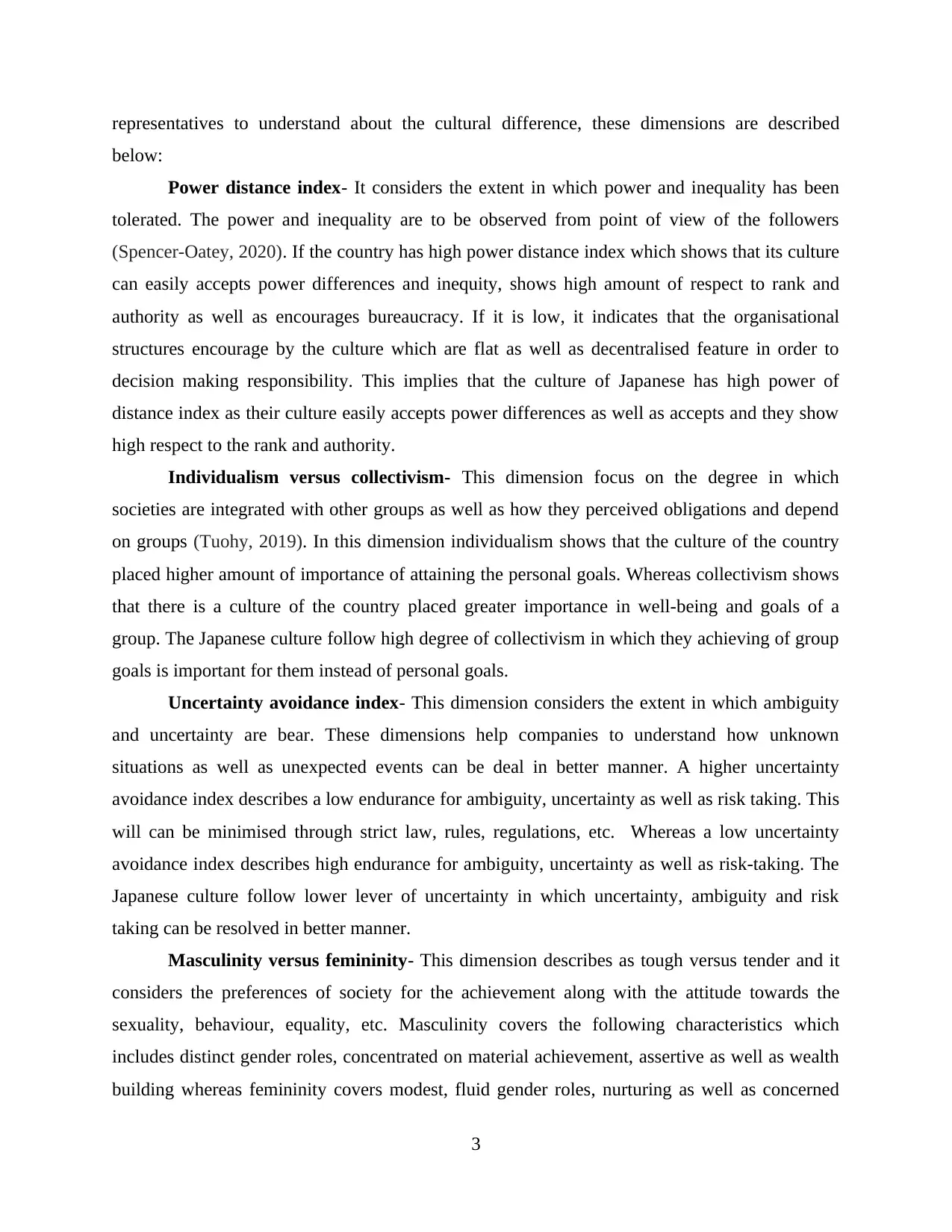
representatives to understand about the cultural difference, these dimensions are described
below:
Power distance index- It considers the extent in which power and inequality has been
tolerated. The power and inequality are to be observed from point of view of the followers
(Spencer-Oatey, 2020). If the country has high power distance index which shows that its culture
can easily accepts power differences and inequity, shows high amount of respect to rank and
authority as well as encourages bureaucracy. If it is low, it indicates that the organisational
structures encourage by the culture which are flat as well as decentralised feature in order to
decision making responsibility. This implies that the culture of Japanese has high power of
distance index as their culture easily accepts power differences as well as accepts and they show
high respect to the rank and authority.
Individualism versus collectivism- This dimension focus on the degree in which
societies are integrated with other groups as well as how they perceived obligations and depend
on groups (Tuohy, 2019). In this dimension individualism shows that the culture of the country
placed higher amount of importance of attaining the personal goals. Whereas collectivism shows
that there is a culture of the country placed greater importance in well-being and goals of a
group. The Japanese culture follow high degree of collectivism in which they achieving of group
goals is important for them instead of personal goals.
Uncertainty avoidance index- This dimension considers the extent in which ambiguity
and uncertainty are bear. These dimensions help companies to understand how unknown
situations as well as unexpected events can be deal in better manner. A higher uncertainty
avoidance index describes a low endurance for ambiguity, uncertainty as well as risk taking. This
will can be minimised through strict law, rules, regulations, etc. Whereas a low uncertainty
avoidance index describes high endurance for ambiguity, uncertainty as well as risk-taking. The
Japanese culture follow lower lever of uncertainty in which uncertainty, ambiguity and risk
taking can be resolved in better manner.
Masculinity versus femininity- This dimension describes as tough versus tender and it
considers the preferences of society for the achievement along with the attitude towards the
sexuality, behaviour, equality, etc. Masculinity covers the following characteristics which
includes distinct gender roles, concentrated on material achievement, assertive as well as wealth
building whereas femininity covers modest, fluid gender roles, nurturing as well as concerned
3
below:
Power distance index- It considers the extent in which power and inequality has been
tolerated. The power and inequality are to be observed from point of view of the followers
(Spencer-Oatey, 2020). If the country has high power distance index which shows that its culture
can easily accepts power differences and inequity, shows high amount of respect to rank and
authority as well as encourages bureaucracy. If it is low, it indicates that the organisational
structures encourage by the culture which are flat as well as decentralised feature in order to
decision making responsibility. This implies that the culture of Japanese has high power of
distance index as their culture easily accepts power differences as well as accepts and they show
high respect to the rank and authority.
Individualism versus collectivism- This dimension focus on the degree in which
societies are integrated with other groups as well as how they perceived obligations and depend
on groups (Tuohy, 2019). In this dimension individualism shows that the culture of the country
placed higher amount of importance of attaining the personal goals. Whereas collectivism shows
that there is a culture of the country placed greater importance in well-being and goals of a
group. The Japanese culture follow high degree of collectivism in which they achieving of group
goals is important for them instead of personal goals.
Uncertainty avoidance index- This dimension considers the extent in which ambiguity
and uncertainty are bear. These dimensions help companies to understand how unknown
situations as well as unexpected events can be deal in better manner. A higher uncertainty
avoidance index describes a low endurance for ambiguity, uncertainty as well as risk taking. This
will can be minimised through strict law, rules, regulations, etc. Whereas a low uncertainty
avoidance index describes high endurance for ambiguity, uncertainty as well as risk-taking. The
Japanese culture follow lower lever of uncertainty in which uncertainty, ambiguity and risk
taking can be resolved in better manner.
Masculinity versus femininity- This dimension describes as tough versus tender and it
considers the preferences of society for the achievement along with the attitude towards the
sexuality, behaviour, equality, etc. Masculinity covers the following characteristics which
includes distinct gender roles, concentrated on material achievement, assertive as well as wealth
building whereas femininity covers modest, fluid gender roles, nurturing as well as concerned
3
⊘ This is a preview!⊘
Do you want full access?
Subscribe today to unlock all pages.

Trusted by 1+ million students worldwide
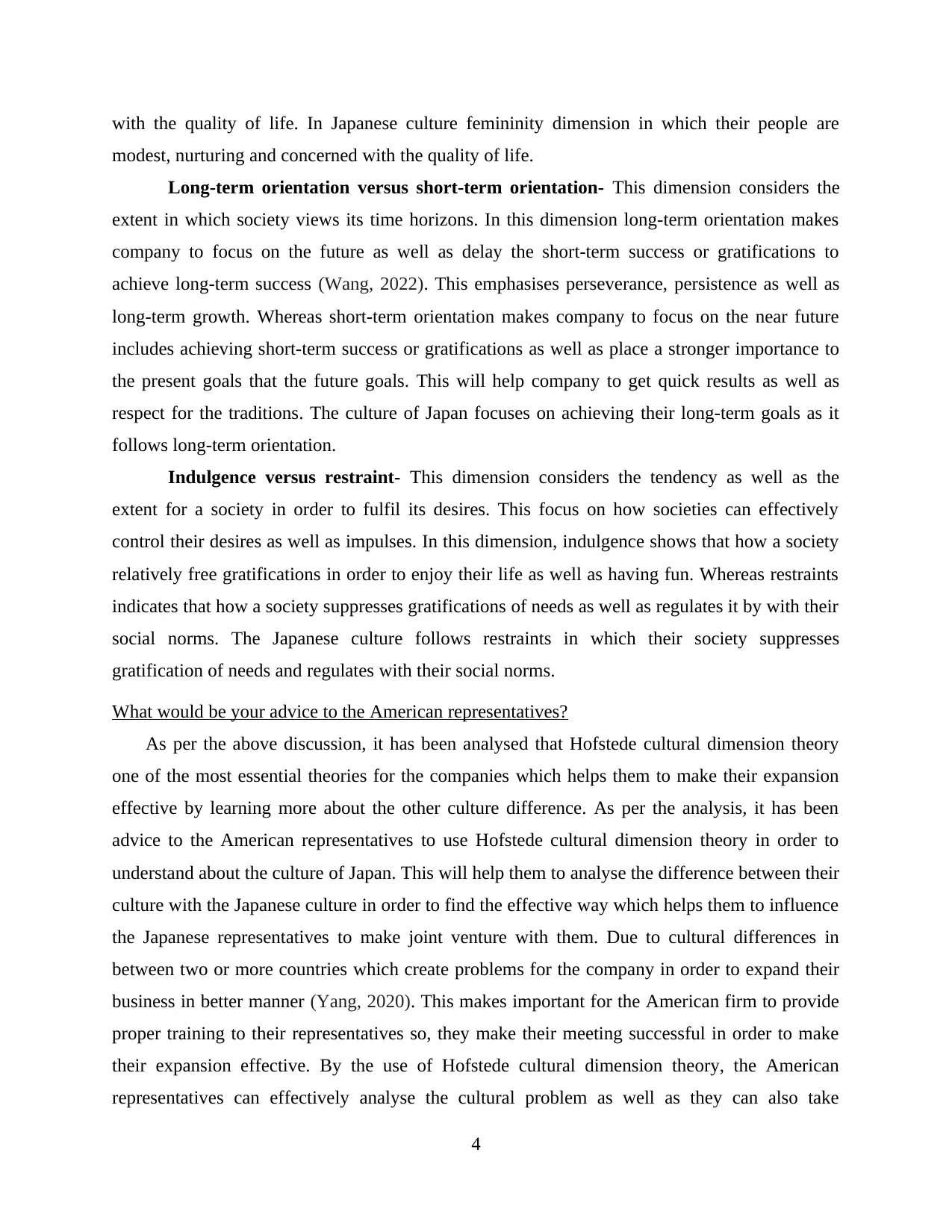
with the quality of life. In Japanese culture femininity dimension in which their people are
modest, nurturing and concerned with the quality of life.
Long-term orientation versus short-term orientation- This dimension considers the
extent in which society views its time horizons. In this dimension long-term orientation makes
company to focus on the future as well as delay the short-term success or gratifications to
achieve long-term success (Wang, 2022). This emphasises perseverance, persistence as well as
long-term growth. Whereas short-term orientation makes company to focus on the near future
includes achieving short-term success or gratifications as well as place a stronger importance to
the present goals that the future goals. This will help company to get quick results as well as
respect for the traditions. The culture of Japan focuses on achieving their long-term goals as it
follows long-term orientation.
Indulgence versus restraint- This dimension considers the tendency as well as the
extent for a society in order to fulfil its desires. This focus on how societies can effectively
control their desires as well as impulses. In this dimension, indulgence shows that how a society
relatively free gratifications in order to enjoy their life as well as having fun. Whereas restraints
indicates that how a society suppresses gratifications of needs as well as regulates it by with their
social norms. The Japanese culture follows restraints in which their society suppresses
gratification of needs and regulates with their social norms.
What would be your advice to the American representatives?
As per the above discussion, it has been analysed that Hofstede cultural dimension theory
one of the most essential theories for the companies which helps them to make their expansion
effective by learning more about the other culture difference. As per the analysis, it has been
advice to the American representatives to use Hofstede cultural dimension theory in order to
understand about the culture of Japan. This will help them to analyse the difference between their
culture with the Japanese culture in order to find the effective way which helps them to influence
the Japanese representatives to make joint venture with them. Due to cultural differences in
between two or more countries which create problems for the company in order to expand their
business in better manner (Yang, 2020). This makes important for the American firm to provide
proper training to their representatives so, they make their meeting successful in order to make
their expansion effective. By the use of Hofstede cultural dimension theory, the American
representatives can effectively analyse the cultural problem as well as they can also take
4
modest, nurturing and concerned with the quality of life.
Long-term orientation versus short-term orientation- This dimension considers the
extent in which society views its time horizons. In this dimension long-term orientation makes
company to focus on the future as well as delay the short-term success or gratifications to
achieve long-term success (Wang, 2022). This emphasises perseverance, persistence as well as
long-term growth. Whereas short-term orientation makes company to focus on the near future
includes achieving short-term success or gratifications as well as place a stronger importance to
the present goals that the future goals. This will help company to get quick results as well as
respect for the traditions. The culture of Japan focuses on achieving their long-term goals as it
follows long-term orientation.
Indulgence versus restraint- This dimension considers the tendency as well as the
extent for a society in order to fulfil its desires. This focus on how societies can effectively
control their desires as well as impulses. In this dimension, indulgence shows that how a society
relatively free gratifications in order to enjoy their life as well as having fun. Whereas restraints
indicates that how a society suppresses gratifications of needs as well as regulates it by with their
social norms. The Japanese culture follows restraints in which their society suppresses
gratification of needs and regulates with their social norms.
What would be your advice to the American representatives?
As per the above discussion, it has been analysed that Hofstede cultural dimension theory
one of the most essential theories for the companies which helps them to make their expansion
effective by learning more about the other culture difference. As per the analysis, it has been
advice to the American representatives to use Hofstede cultural dimension theory in order to
understand about the culture of Japan. This will help them to analyse the difference between their
culture with the Japanese culture in order to find the effective way which helps them to influence
the Japanese representatives to make joint venture with them. Due to cultural differences in
between two or more countries which create problems for the company in order to expand their
business in better manner (Yang, 2020). This makes important for the American firm to provide
proper training to their representatives so, they make their meeting successful in order to make
their expansion effective. By the use of Hofstede cultural dimension theory, the American
representatives can effectively analyse the cultural problem as well as they can also take
4
Paraphrase This Document
Need a fresh take? Get an instant paraphrase of this document with our AI Paraphraser
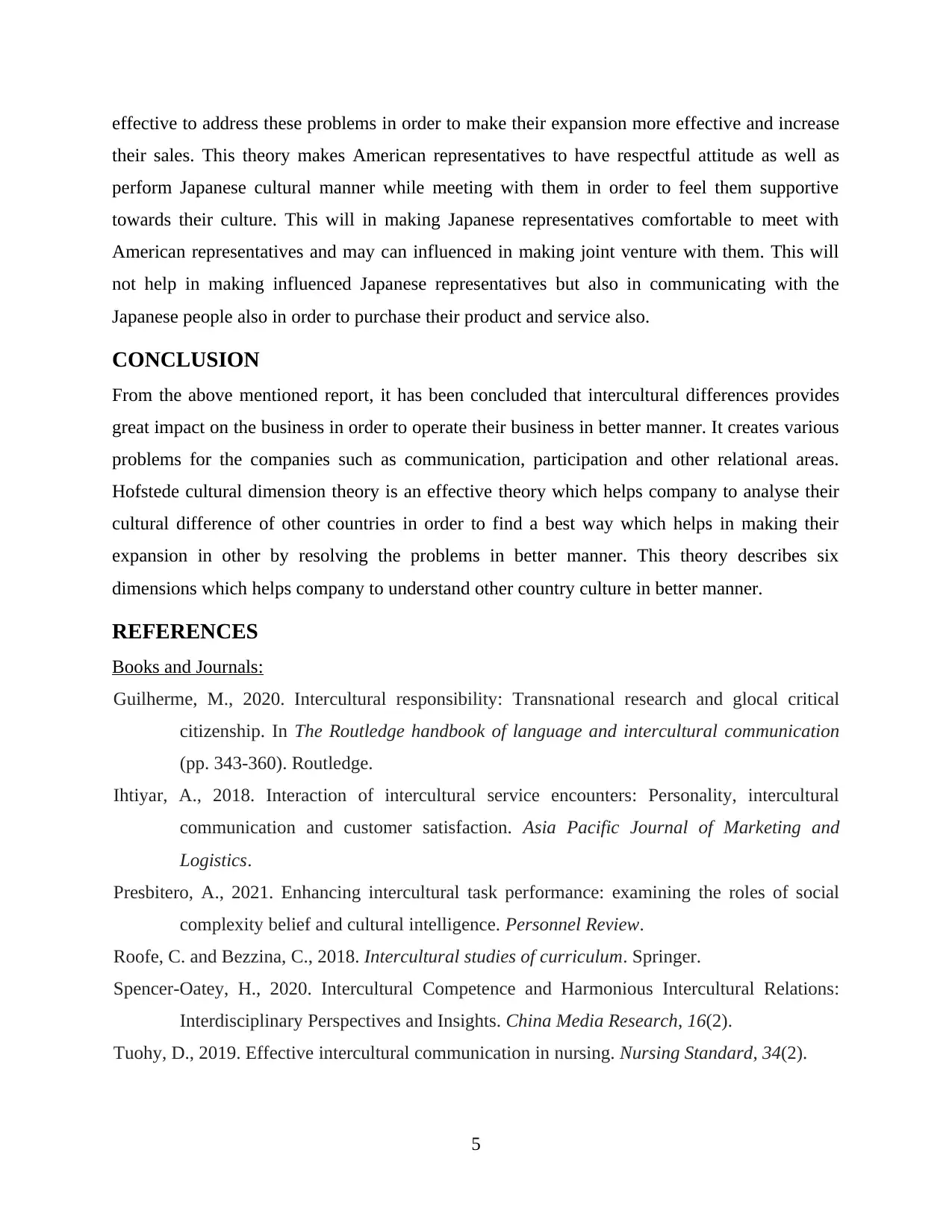
effective to address these problems in order to make their expansion more effective and increase
their sales. This theory makes American representatives to have respectful attitude as well as
perform Japanese cultural manner while meeting with them in order to feel them supportive
towards their culture. This will in making Japanese representatives comfortable to meet with
American representatives and may can influenced in making joint venture with them. This will
not help in making influenced Japanese representatives but also in communicating with the
Japanese people also in order to purchase their product and service also.
CONCLUSION
From the above mentioned report, it has been concluded that intercultural differences provides
great impact on the business in order to operate their business in better manner. It creates various
problems for the companies such as communication, participation and other relational areas.
Hofstede cultural dimension theory is an effective theory which helps company to analyse their
cultural difference of other countries in order to find a best way which helps in making their
expansion in other by resolving the problems in better manner. This theory describes six
dimensions which helps company to understand other country culture in better manner.
REFERENCES
Books and Journals:
Guilherme, M., 2020. Intercultural responsibility: Transnational research and glocal critical
citizenship. In The Routledge handbook of language and intercultural communication
(pp. 343-360). Routledge.
Ihtiyar, A., 2018. Interaction of intercultural service encounters: Personality, intercultural
communication and customer satisfaction. Asia Pacific Journal of Marketing and
Logistics.
Presbitero, A., 2021. Enhancing intercultural task performance: examining the roles of social
complexity belief and cultural intelligence. Personnel Review.
Roofe, C. and Bezzina, C., 2018. Intercultural studies of curriculum. Springer.
Spencer-Oatey, H., 2020. Intercultural Competence and Harmonious Intercultural Relations:
Interdisciplinary Perspectives and Insights. China Media Research, 16(2).
Tuohy, D., 2019. Effective intercultural communication in nursing. Nursing Standard, 34(2).
5
their sales. This theory makes American representatives to have respectful attitude as well as
perform Japanese cultural manner while meeting with them in order to feel them supportive
towards their culture. This will in making Japanese representatives comfortable to meet with
American representatives and may can influenced in making joint venture with them. This will
not help in making influenced Japanese representatives but also in communicating with the
Japanese people also in order to purchase their product and service also.
CONCLUSION
From the above mentioned report, it has been concluded that intercultural differences provides
great impact on the business in order to operate their business in better manner. It creates various
problems for the companies such as communication, participation and other relational areas.
Hofstede cultural dimension theory is an effective theory which helps company to analyse their
cultural difference of other countries in order to find a best way which helps in making their
expansion in other by resolving the problems in better manner. This theory describes six
dimensions which helps company to understand other country culture in better manner.
REFERENCES
Books and Journals:
Guilherme, M., 2020. Intercultural responsibility: Transnational research and glocal critical
citizenship. In The Routledge handbook of language and intercultural communication
(pp. 343-360). Routledge.
Ihtiyar, A., 2018. Interaction of intercultural service encounters: Personality, intercultural
communication and customer satisfaction. Asia Pacific Journal of Marketing and
Logistics.
Presbitero, A., 2021. Enhancing intercultural task performance: examining the roles of social
complexity belief and cultural intelligence. Personnel Review.
Roofe, C. and Bezzina, C., 2018. Intercultural studies of curriculum. Springer.
Spencer-Oatey, H., 2020. Intercultural Competence and Harmonious Intercultural Relations:
Interdisciplinary Perspectives and Insights. China Media Research, 16(2).
Tuohy, D., 2019. Effective intercultural communication in nursing. Nursing Standard, 34(2).
5
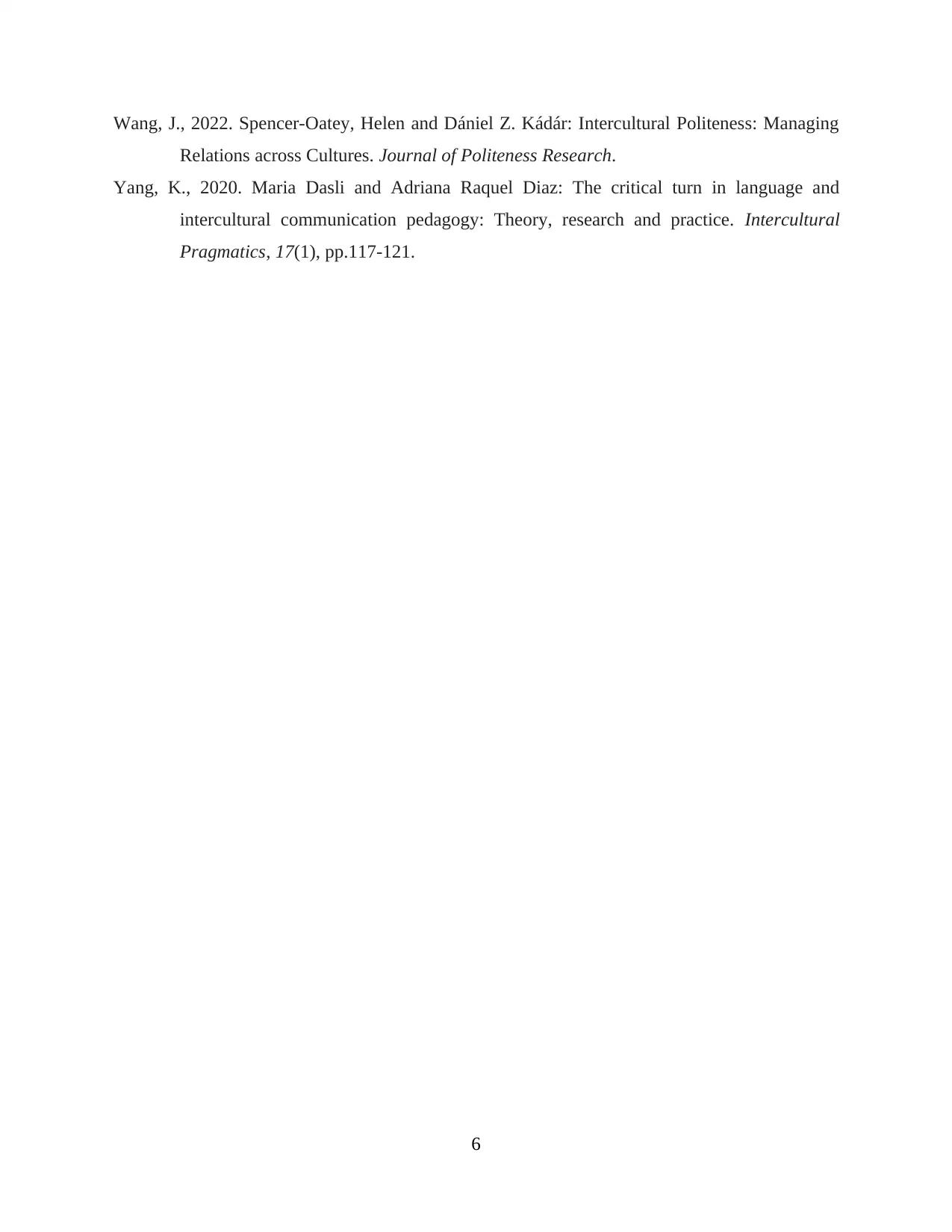
Wang, J., 2022. Spencer-Oatey, Helen and Dániel Z. Kádár: Intercultural Politeness: Managing
Relations across Cultures. Journal of Politeness Research.
Yang, K., 2020. Maria Dasli and Adriana Raquel Diaz: The critical turn in language and
intercultural communication pedagogy: Theory, research and practice. Intercultural
Pragmatics, 17(1), pp.117-121.
6
Relations across Cultures. Journal of Politeness Research.
Yang, K., 2020. Maria Dasli and Adriana Raquel Diaz: The critical turn in language and
intercultural communication pedagogy: Theory, research and practice. Intercultural
Pragmatics, 17(1), pp.117-121.
6
⊘ This is a preview!⊘
Do you want full access?
Subscribe today to unlock all pages.

Trusted by 1+ million students worldwide
1 out of 9
Related Documents
Your All-in-One AI-Powered Toolkit for Academic Success.
+13062052269
info@desklib.com
Available 24*7 on WhatsApp / Email
![[object Object]](/_next/static/media/star-bottom.7253800d.svg)
Unlock your academic potential
Copyright © 2020–2025 A2Z Services. All Rights Reserved. Developed and managed by ZUCOL.
